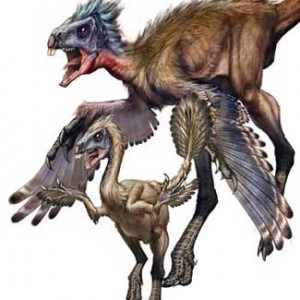Some of the most exciting finds of the last couple of decades were the discovery of feathered dinosaurs. These fossils mostly have come from fine-grained formations of the Cretaceous Period in China, where feather impressions were preserved along with the bones. Each of these fossils gives us a snapshot image of the body covering sported by that species. Other recent finds have even given us clues to the coloration of the feathers in a few species.
In yet another new find, announced in the April 29 issue of Nature, we learn that the feathery covering may have fundimentally changed over the lifetime of individuals of at least one species. Two small oviraptors in the genus Similicaudipteryx were preserved at different stages of their life history, each showing the pattern of feathers covering the body at different life stages.

Artist reconstruction of a juvenile and adult Similicaudipteryx. Artwork by Xing Lida and Song Qijin
The smaller, juvenile individual had short flight feathers with a “ribbon-like” stem on its forearms, much long feathers on the tail, and a downy covering over the rest of its body. The larger, young adult individual showed a different pattern, with much longer, and more developed flight feathers with a strong central shaft on the forearm. Thus, the flight feathers of the forearm show two very different morphologies at the two life stages. This does not happen in modern birds, where the flight feathers that emerge on the juveniles are the same, only smaller versions of the adult feathers.
There is some debate that this interpretation of the fossils is correct. It could be, argue some paleontologists, that the smaller individual was preserved during a molting phase, with the new feathers only partially emerged from the tube-like sheath that feathers form in. In other words, they suggest that the different morphology is only temporary and an artifact of preservation. The authors of the original paper maintain it is not an artifact based upon the proportions of the feathers. So, we need to keep digging.
It is now accepted that the ancestors of birds were the theropod (meat-eating) dinosaurs. It is clear from these fossils, and many similar ones, that birds inherited their feathers from dinosaurs, and we have greatly expanded our knowledge of feather evolution with the last few years.
Other dinosaur related posts can be found here. Just search or select the category.